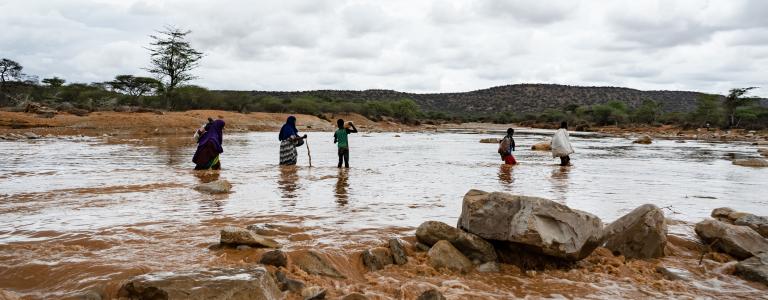Climate Security and Peacebuilding in a Time of Converging Crises
While rarely in and of itself a sole driver of violence, climate change impacts can exacerbate traditional drivers of conflict. The international community must come together to help vulnerable countries build resilience on all fronts.
Climate change has long been considered a contributing factor to conflict and instability. Risks are particularly acute and amplified in states currently suffering from weak governance.
We sat down with Alec Crawford, Senior Policy Advisor and Lead on IISD's Environment, Conflict and Peacebuilding work, to discuss the United Nations Security Council's open debate on climate security, held on February 23: what came out of this, and how can the international community join forces to help?
What happened during the meeting, and why is it important?
The Government of the United Kingdom, which currently holds the presidency of the Security Council, hosted an open debate on the role of the Council and the United Nations more broadly in addressing the security risks posed by climate change in conflict-affected settings. British Prime Minister Boris Johnson highlighted the need for the Security Council to push for urgent action in building resilience in fragile states, reducing their vulnerability to both climate impacts and potential conflict risks.
What do these risks look like?
Climate change acts as a threat multiplier. It's not necessarily seen as a driver of conflict in and of itself, but it can exacerbate existing drivers: a history of tensions, poverty, ethnic differences, or inequality. By displacing communities and increasing competition over natural resources like land and water, climate change can heighten the risk of those conflict drivers, leading to broader grievances and, potentially, violence. This is particularly the case in contexts of weak governance.
The international community is recognizing not only that climate change undermines stability and peace but also that conflict increases climate vulnerability. Efforts at addressing climate and conflict have to go hand in hand.
How has IISD worked to link these two agendas?
IISD has been working in this space for about 15 years now. Through field research in places like the Sahel and the Middle East, we initially examined the links between climate change and insecurity.
We are now focusing on climate-resilient peacebuilding and conflict-sensitive climate programming. For example, how can you design these programs to ensure they enhance peacebuilding in fragile contexts? Most concretely, we've been looking at how to integrate and align National Adaptation Plan processes in conflict-affected states with peacebuilding agendas.
As the world seems to be focused on lowering greenhouse gas emissions, would you say that there's equal urgency for climate mitigation and adaptation? Can they both be used to protect communities from environment-related conflicts?
There is, first and foremost, an urgent need for significant emission reductions from the international community. But for many conflict-affected countries, mitigation is secondary, given they're just not significant emitters. For them, the focus has to be adaptation: reducing vulnerability to climate impacts, increasing adaptive capacities among communities and individuals, and strengthening government capacities to cope with an increasingly variable climate.
Conflict only serves to increase vulnerability to climate change and make adaptation more difficult.
Unfortunately, even if we take dramatic action now to reduce emissions, a certain degree of climate change is inevitable and is, in fact, already happening. Because of that, investing time and money to support climate adaptation is crucial.
What should international leaders' next steps be to help build climate resilience in conflict-affected countries?
We recently conducted a series of peer exchanges with representatives from Somalia, Nigeria, and Sierra Leone, whose countries are all in different stages of the peacebuilding process. They reiterated that their governments are already overstretched, under-resourced, and under-capacitated.
They need more resources—financial and human—to focus on climate risks and vulnerabilities and to bring together the adaptation and peacebuilding agendas as much as possible; alignment will help with addressing the shared drivers of vulnerability to both conflict and climate.
For international leaders, the focus must be on supporting both adaptation and peacebuilding in these contexts. Conflict only serves to increase vulnerability to climate change and make adaptation more difficult, while the changing climate further undermines stability. It's a vicious cycle that can spiral out of control unless we take a holistic and integrated approach to addressing these challenges.
***
With the UN Security Council's broad recognition of the links between climate change and security, the international community is one step closer to enhancing their support for vulnerable countries' adaptation efforts. There is a clear need to build resilience to both climate change and conflict in these regions, so let's push for these discussions to turn into action.
You might also be interested in
The Coral Gardeners of Saint Lucia: Local heroes against coral bleaching
Coral gardeners in Saint Lucia are working together to save reefs from the devastating effects of climate change through a flagship project under the island's National Adaptation Plan (NAP).
Five Ways the Global Goal on Adaptation can Help Build a Global Monitoring, Evaluation, and Learning System for Adaptation by COP 28
With the 58th meeting of the United Nations Framework Convention on Climate Change’s (UNFCCC) Subsidiary Bodies (SBs) due to kick off in Bonn, Germany, on June 5, one of the key issues to watch in the realm of climate change adaptation are the talks on the Global Goal on Adaptation (GGA).
Last Call for the Global Stocktake
The 2023 Bonn Climate Change Conference will be the last opportunity for countries and relevant stakeholders to provide technical inputs into the two-year Global Stocktake process. What are our expectations on adaptation?
IISD Announces Orville Grey to Lead the NAP Global Network
IISD welcomes Orville Grey as the new Head of Secretariat, NAP Global Network.
